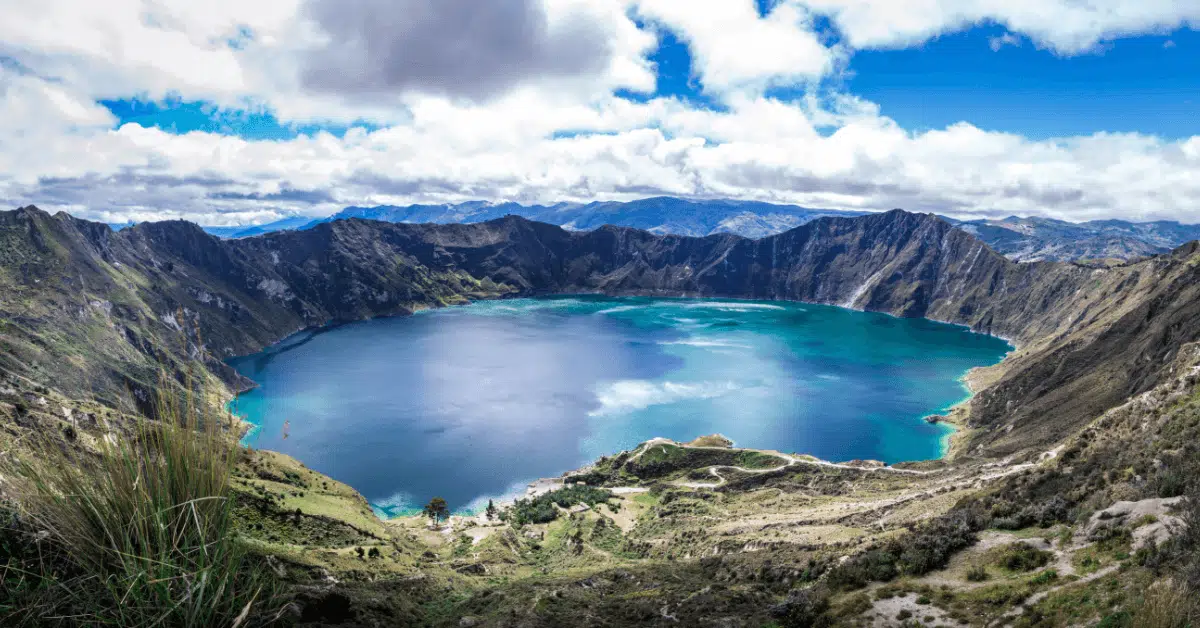Quilotoa Lake + Quilotoa Loop Trek: Ultimate Guide
Home to a stunning volcanic crater lake you have to see to believe, Quilotoa, Ecuador is one of the highlights of Ecuador. Also known as Laguna Quilotoa, this blue-green crater lake is one of a kind, and located in one of the most beautiful corners of mountainous Ecuador; it’s a must on your Ecuador itinerary whether you’re here for a week or a month.
Also known for being the start (or end!) of the famed Quilotoa Loop trek, one of South America’s most epic multi-day treks, Quilotoa has plenty of hiking opportunities for those looking to enjoy the scenery. We visited Quilotoa at least a half-dozen times while we lived in Ecuador for several years, and each time we were even more impressed with its beauty.
Our ultimate guide to Quilotoa, Ecuador has everything you need to plan your visit. Keep reading for our Quilotoa Loop map, and to discover the different hikes in and around the Quilotoa lagoon, plus some of our top tips for enjoying the area and making the most out of your visit.
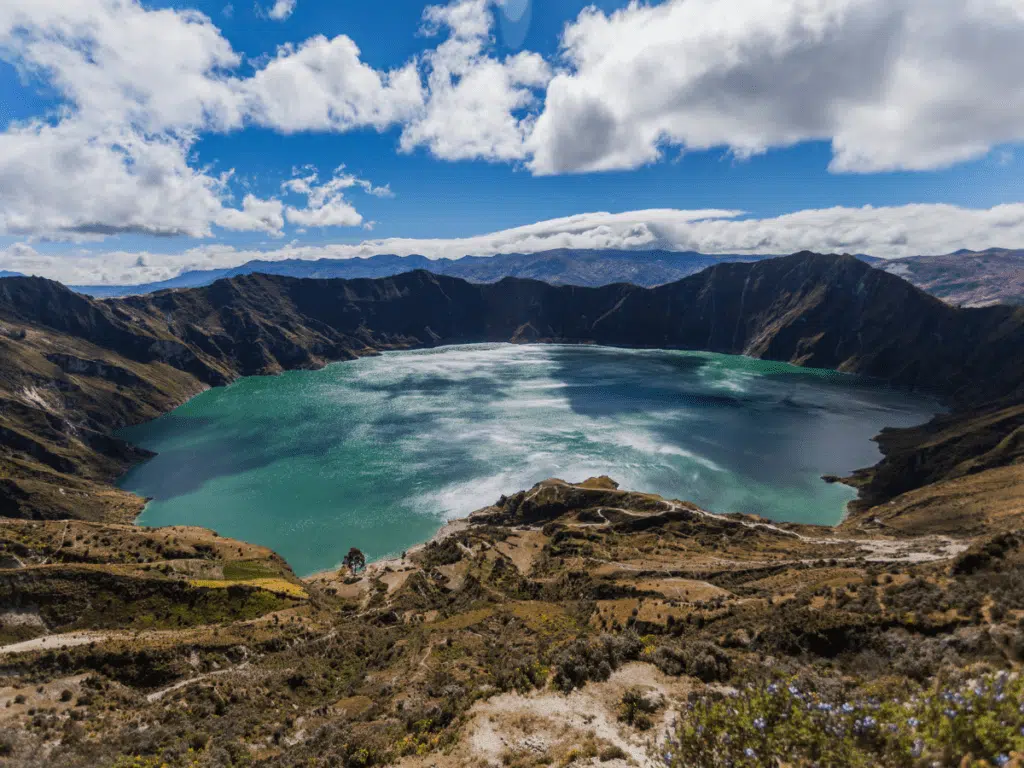
This post contains affiliate links that may reward me monetarily or otherwise when you use them to make qualifying purchases – at no cost to you. As an Amazon Associate, I earn from qualifying purchases. For more information, please read our disclosure policy.
Quilotoa Ecuador
Home to the famous Quilotoa Crater Lake, Quilotoa Ecuador is easily one of the most beautiful places in Ecuador. Even after visiting multiple times, that first glimpse into the crater hits like a ton of bricks and leaves your jaw on the floor. Pictures don’t even come close to doing it justice.
While Quilotoa is home to the famous Quilotoa Loop trek, there is much more to do and see here than just completing this multi-day trek. Don’t let the fame of the trek stop you from visiting if you have less time – there are other hiking routes around the crater (easier and much shorter!). Even if you just want to see the crater and not hike a step, Quilotoa’s spectacular beauty is worth the visit.
Located in central Ecuador in the middle of the Andes mountain range, Laguna Quilotoa (the Quilotoa Lagoon) is extremely remote – to get here requires a nearly two-hour drive into the middle of the remote mountains from the nearest large city of Latacunga.
This means getting here takes some planning, though it’s more than worth it.
Thankfully, you can take easy day trips to Quilotoa from Quito – we’ve used this organized day trip from Quito when traveling with family and it was excellent; highly recommended! In addition, frequent buses connect Quilotoa to Latacunga and other nearby cities, helping the tiny town of Quilotoa Ecuador and its most beautiful attraction become one of the most popular destinations for visitors to the country.
Quilotoa Lake
The Quilotoa Crater Lake as we see it today sits within an extinct volcano and was formed during a massive volcanic explosion centuries ago. The crater was formed when the volcano’s massive cone collapsed in on itself, leaving the crater in its place, which became a lake when it filled with water.
Despite not having the typical appearance of a volcano, Quilotoa is easily one of the most spectacular volcanoes in South America!
Looking for some Quilotoa Lake facts? Here are a few we learned during our visit that might surprise you.
- The last major eruption here occurred in 1280 AD.
- This eruption was one of the most powerful recorded on Earth in the last 1000 years, with volcanic flow reaching all the way to the Pacific Ocean.
- The water in Laguna Quilotoa is 250 meters deep (820 feet) at its deepest point.
Quilotoa is located within the Illinizas Ecological Reserve, a larger ecological reserve within Ecuador that includes the Illinizas, a pair of volcanic mountains nearby considered among the more challenging summits in Ecuador.
Can You Swim in Quilotoa?
No – you definitely can’t swim in the Quilotoa Crater Lake! The water in Quilotoa Lagoon is a brilliant greenish-blue due to dissolved minerals and chemicals related to the volcanic activity here.
While is not recommended to swim in the lake water, kayaks are available to rent at the bottom of the crater to explore the lake.
You may be able to see the active fumaroles (expulsions of gases from below the surface that form streams of large bubbles) within the Quilotoa lake as you kayak or complete the Quilotoa crater lake hike. These also cause hot springs in parts of the water of the lake.
Quilotoa Elevation
It is important to be aware of the elevation you can expect to experience in Quilotoa before planning your trip. Quilotoa is 12,841 feet / 3,914 meters at the highest point of the crater rim. The elevation is similar while hiking the Quilotoa Loop, though you’ll be headed uphill and downhill at points throughout the trek.
In comparison, Quito sits at about 9,350 feet / 2,850 meters. Quito is the second-highest capital in the world, after La Paz, Bolivia.
Quilotoa elevation means that unless you’re already well adapted to the altitude, you will definitely feel the elevation here. You will likely get winded more easily, especially when walking up or downhill, or when you exert yourself too much physically.
This is something to keep in mind when you’re planning your hikes in the area – you might not be as speedy as you think. Even living at an elevation outside of Quito for two years, I could tell the difference when I visited Quilotoa that I was much higher still!
This elevation means it can get cold here quickly. Even when you’re in full sun, you’ll feel the wind and cold here. Come prepared with warm clothes, and make sure you dress in layers that you can take off.
What To Pack for Ecuador
Check out our Ultimate Ecuador Packing List to help you pack for your trip – we’re sharing exactly what to bring to Ecuador and what we never travel without.
Quilotoa Hike
While the Quilotoa Loop is by far the most famous Quilotoa hike, there is no single “Quilotoa hike” or hiking route, which is part of what makes this destination such a great one. You can plan a short Quilotoa day trip and enjoy the view, visit for a day and hike the rim, or visit for several days dedicated entirely to hiking.
These are Quilotoa’s top hiking routes:
- The Quilotoa Loop, a multi-day trek that is one of South America’s best;
- The Quilotoa Crater Hike, into the crater and down to the water, and out again;
- The Quilotoa Rim Hike, around a portion of or the entirety of the crater’s rim.
Regardless of how much time you have to spend here, I always recommend choosing to include some hiking in your itinerary if you’re looking to come to Quilotoa (rather than just making it to the viewpoint and leaving).
Even a short hike along a portion of the crater’s rim will give you more than one view, and the best opportunity to experience the beauty of the area. Beyond just the crater, the area around Quilotoa is wild and mountainous, giving you a varied and beautiful view everywhere you look.
Whatever you’re planning, come dressed in layers for the cold, well-prepared to be in such an isolated area… and mostly, ready to be wowed by the scenery at Quilotoa.
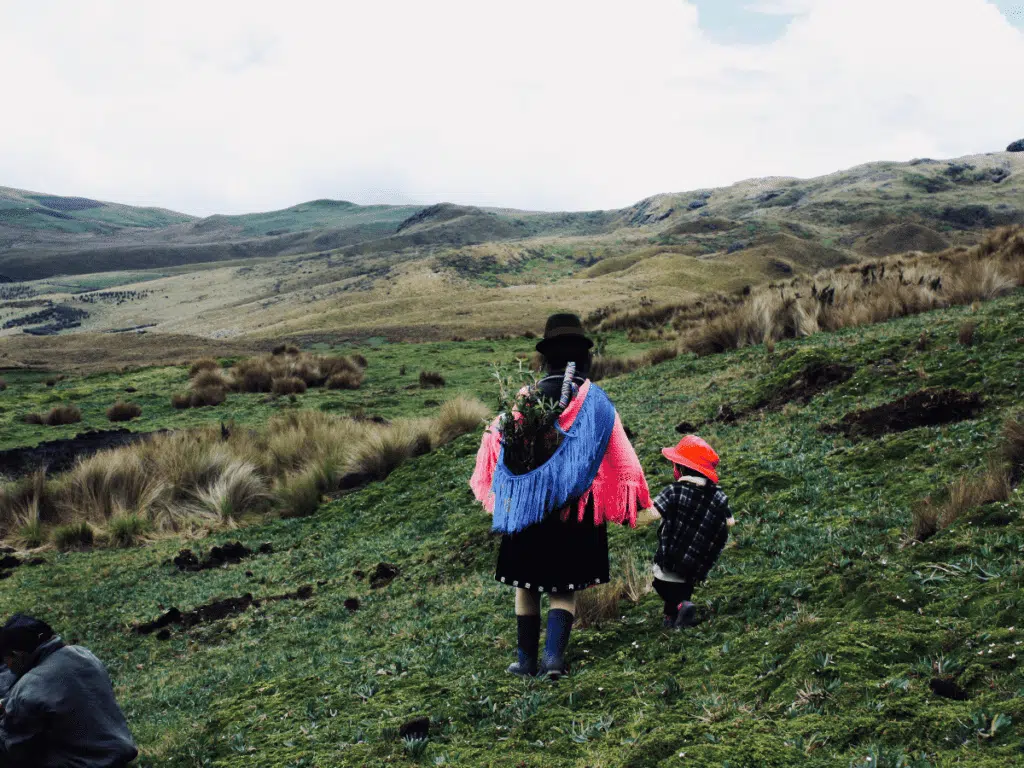
Quilotoa Loop
The Quilotoa Loop is why Quilotoa Ecuador is best known as a destination for hiking. The Quilotoa Loop is easily one of the most popular treks in South America, and likely the most famous trek in Ecuador.
This multi-day hike takes you around the Quilotoa Crater Lake and through the surrounding countryside to visit remote villages and past incredible vistas. Hiking the Quilotoa Loop is easily one of South America’s best adventures and part of why Quilotoa is regularly rated one of the best places to visit in South America.
While the trek is called a “loop,” the loop almost always stops and starts with a bus ride to and from the largest nearby city of Latacunga. Unless you attempt the challenging hike from Latacunga into the mountains, the actual Quilotoa Loop is more of a straight trek.
Once in Quilotoa or a neighboring town, there are several variations to this popular trek with ways to add destinations along the way.
Regardless of the exact Quilotoa Loop map you choose, hiking the Quilotoa Loop is an incredible (and extremely affordable!) trek and one I highly recommend to those travelers who can build out the time for it in their itinerary.
Best Hotels & Hostels in Quilotoa
- Hosteria Chukirawa ($ – $$)
- Hosteria Alpaka Quilotoa ($ – $$)
- Hostal Mama Hilda ($$)
Quilotoa Loop Map
This map shows the most common path of the Quilotoa Loop trek. The purple line represents the destinations most commonly trekked, and the red line represents the part of to loop most commonly completed by bus.
In this map, I’ve included the trek from Quilotoa to Zumbahua as a “trekking” portion of the path, though this is a less frequent addition to the most common 3-4 day route stretching between Sigchos and Quilotoa.
Feel free to click on the map below for a closer look at the destinations and to get a better idea of the route along the way
Quilotoa Loop Hike
The most popular routes for the Quilotoa Loop are the following:
- Latacunga > Sigchos > Isinlivi > Chugchilan > Quilotoa > Latacunga
- Latacunga > Quilotoa > Chugchilan > Isinlivi > Sigchos > Latacunga
Both of these routes start in Latacunga by taking the public bus or private transportation from Latacunga to either Sigchos or Quilotoa. While it’s possible to hike all the way from Latacunga to the start of these routes, it’s almost never attempted as it’s extremely challenging and would add a few days of hiking to your itinerary.
While there are some additional trail spurs and bonus treks to add to your Quilotoa Loop experience, the Sigchos to Quilotoa and Quilotoa to Sigchos routes are the most common.
Most people do the hike in 3-5 days and take the route that starts by taking the bus to Quilotoa.
Alternatively, you can do the popular route in “reverse,” and start in Sigchos and end in Quilotoa. If you do this “reverse” route, you get the bonus of ending the route at Quilotoa, which makes for quite the grand finale – you’ll feel like you earned every second of that immaculate view. I recommend the Sigchos to Quilotoa route, for sure!
An Easier Quilotoa Loop?
There is some talk of the Quilotoa to Sigchos route being “easier” as more of it is downhill, but there really is not much to this theory. Taking either route you will encounter major ups and downs with some strenuous hiking portions – so it isn’t exactly “easy” going either way.
Quilotoa Loop Tips
Looking for some tips before heading out to conquer the Quilotoa Loop? While the hike is relatively straightforward and paths getting clearer with every year it seems, here are some things we wish someone had told us before we embarked:
- Bring plenty of layers! Quilotoa is quite cold and windy, so be prepared with warm clothing. Even a light, packable down jacket is recommendable, even if you travel in summer.
- Do not be afraid to ask for directions! Locals, even in these remote mountain towns, are used to seeing and interacting with hikers and are quite helpful. Plus, the kids will love meeting you – they are precious.
- Bring cash! No ATMs are along the route, and you can’t use cards. Make sure to take out enough cash in Latacunga for the duration of your trip.
- Bring snacks! You’ll get hungry and want to eat all of your snacks immediately… trust me.
- Bring a poncho or rain jacket! Even if you’re traveling in the dry season, you don’t want to get stuck in a stray rainstorm. There isn’t a lot of coverage here as the elevation is too high for trees.
What To Pack for Ecuador
Check out our Ultimate Ecuador Packing List to help you pack for your trip – we’re sharing exactly what to bring to Ecuador and what we never travel without.
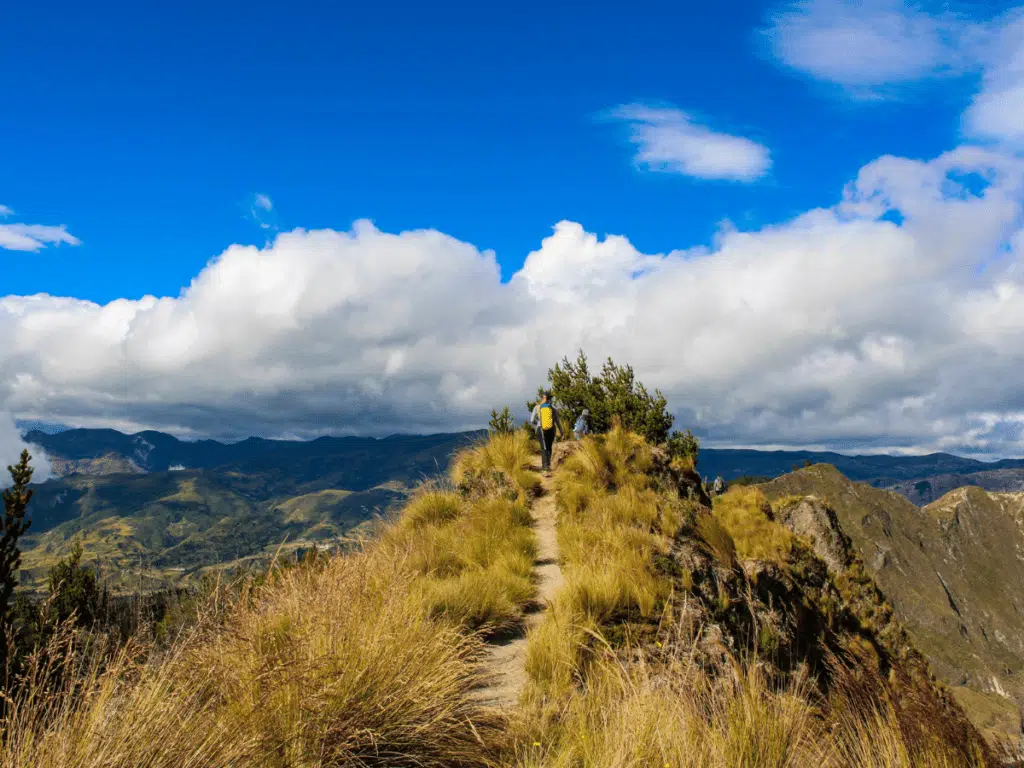
Quilotoa Crater Hike
For those who can’t build the full Quilotoa Loop trek into their itinerary, there are some other beautiful hikes in Quilotoa, including the classic crater hike – hiking into and out of the crater, down to the water’s edge.
This is a fantastic hike for those on a day trip to Quilotoa who want to get some hiking in while here and enjoy some incredible views of the lake.
Near the water’s edge, there are places to sit and relax, a swing over the water, plus a small stand that sells water and snacks. You’ll find kayaks for rent on the water, which is great fun and a relaxing way to spend some of the afternoon exploring the edges of the crater.
Make sure you come prepared for the Quilotoa Crater Hike by wearing layers – once you get into the crater, the crater will block the wind and you’ll get much warmer. Plus, come prepared with good sneakers or hiking boots, plenty of water, and snacks.
Be aware that the hiking path into the crater is sandy. Though there are some areas with steps built into the path, it can sometimes be tricky to navigate. Taking your time and watching your step should be enough to do the trick.
Given the extreme elevation at Quilotoa, the hike out of the crater can be a real challenge, especially with the sandy path. Be prepared for it to take double the time to exit the crater as it did to enter.
Locals rent mules to take visitors from the crater lake to the top of the crater for $10-15 – this is worth considering if you’re not yet adjusted to the altitude or not as physically fit. If you’re not looking for too much of a physical challenge, I’d recommend considering this to get back to the top of the crater!
Best Hotels & Hostels in Quilotoa
- Hosteria Chukirawa ($ – $$)
- Hosteria Alpaka Quilotoa ($ – $$)
- Hostal Mama Hilda ($$)
Quilotoa Rim Hike
Other than the Quilotoa Crater Hike, the hike around the entire volcanic crater’s rim is the second most common for day-trip Quilotoa visitors.
Taking the route around the rim of the Quilotoa crater is fantastic if you’re looking for more than just entering the crater, and the views are much, much better of Quilotoa Lake and the surrounding countryside.
The hike around the rim takes about four hours (though I’ve heard of people finishing it in three, or five), and the route is well-defined. In most parts, there isn’t too much of a grade, so it is not as vertically challenging as the hike into and out of the crater.
Overall, the Quilotoa Rim Hike is about 3 km long and is generally considered an easy to moderate hike.
Quilotoa Day Trips
With just a day trip to Quilotoa, you won’t have time for much hiking in Quilotoa other than the crater hike into and out of the crater, or the rim hike. Most small-group excursions to Quilotoa from Quito include time to hike into and out of the crater – our Quilotoa tour with Quito Tour Bus (which we loved!) included time for this hike.
While both of these hikes are doable if you’re coming to Quilotoa from Quito with private transportation, it would be challenging to do either if you’ll be taking a public bus to or from Quito.
If you’re planning on taking the bus, plan on staying at least one night in Quilotoa or in Latacunga – this will give you enough time to catch the last bus from Quilotoa or the first bus from Latacunga to Quilotoa in the morning.
However, there are some very popular day trips with private transportation that can be arranged from Quito, Latacunga, or Cuenca and are rather inexpensive and will save you the trouble of having to stick to public bus schedules in this remote town.
Excursions to Quilotoa from Quito
A very popular option for visitors with a limited time is a day trip to Quilotoa from Quito. I did a full-day tour with transportation to and from Quito on one of my visits to Quilotoa, Ecuador (with my mom!) and it was a great option for our itinerary.
I can thoroughly recommend this tour from Quito with transportation included for those on a tight time frame.
While there are companies that offer day tours to Quilotoa from Guayaquil, the journey is far too long for a day, and an overnight stay in Quilotoa, or even nearby Latacunga, is really necessary to enjoy the experience given the travel time.
While private transportation and guides can be arranged from anywhere in Ecuador, some of the most popular and well-established tours are from Quito, and others include stops at Cotopaxi National Park.
Multi-Day Quilotoa Tours
There are also several multi-day Quilotoa tour options that leave from Quito, including those that combine visits to the nearby Cotopaxi Volcano in Cotopaxi National Park (a must-see destination in Ecuador!).
They often include staying in a lodge, like this popular option, which is a fantastic way to enjoy the national park.
Another popular tour is a 3-day, 2-night tour of Cotopaxi, Quilotoa, and an excursion to Baños: this awesome tour is from a very popular company that I know does a great job in Ecuador. If you haven’t considered adding Baños to your itinerary, definitely look into it – it’s known for its adventure sports but is also a great place to relax.
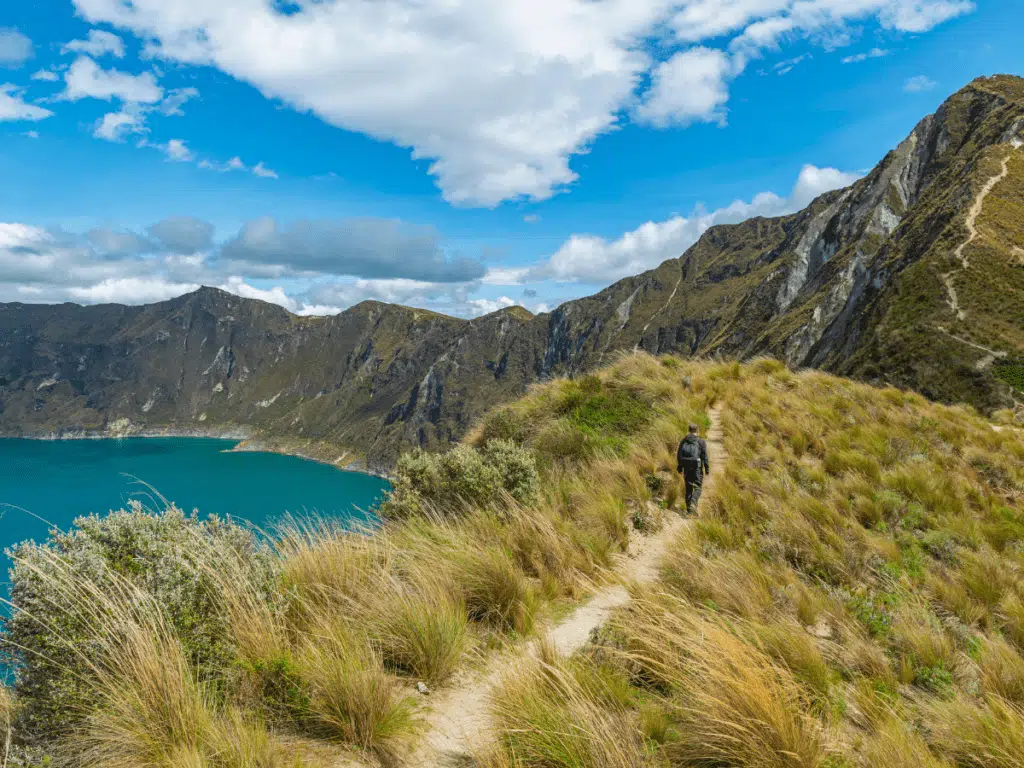
Travel Essential
Don’t think about traveling without a good VPN (Virtual Private Network). Using a VPN while connecting to the internet is an easy way to keep your personal information safe from hackers and trackers. We’ve used NordVPN for years and couldn’t recommend it more – it’s a must for safety online, at home or abroad.
How To Get to Quilotoa
Quito to Quilotoa
The drive from Quito to Quilotoa is about three and a half or four hours, depending on traffic coming in to and leaving Quito. This makes it possible to visit Quilotoa for a day trip, though it can be challenging to do unless you plan on taking private transportation.
Buses from Quito to Quilotoa
Buses from Quito to Quilotoa leave from the Quitumbe bus station in the south of Quito. Look for the ticketing booth of the “Las Illinizas” bus company, which offers direct service from Quito to Quilotoa, leaving at 5:00 p.m. every day for about $3.
The trip takes between 3 and 4 hours.
There are many more options for buses from Quito to Latacunga, the nearest large city to Quilotoa, where buses leave every hour to Quilotoa.
Several bus companies in Quitumbe bus station offer buses to Latacunga. It is generally the easiest option for most travelers to first head to Latacunga, then take a bus to Quilotoa from there.
Latacunga to Quilotoa
Buses leave about every hour to Quilotoa from Latacunga until the late afternoon and take about two hours or two and a half hours to reach Quilotoa. The view is stunning, as you’ll wind up from the valley where Latacunga sits through the mountains.
Another alternative, if you happen to find yourself at the bus station between bus departure times, is to take a bus from Latacunga to Zumbahua, the closest town on the route to Quilotoa – there are more frequent buses headed here.
You should then be able to get a taxi or pickup truck ride from Zumbahua to Quilotoa for around $5.
Baños to Quilotoa
Quilotoa is located close to the small town of Baños de Agua Santa (more commonly, Baños) which is another popular destination for travelers and is particularly famous for its adventure sports.
While only a 3-hour direct drive away, there is no direct bus between the two cities, so you’ll have to travel through Latacunga if you don’t have private transportation.
Departing Quilotoa
Make sure to ask the locals when the last bus of the day departs from Quilotoa – any local will be able to tell you the bus schedule. It usually departs before the sun sets, so don’t expect or plan for a very late departure from Quilotoa.
Buses are unlikely to sell out unless it is a holiday weekend in Ecuador.
If you miss the last bus out of Quilotoa, don’t worry – you can easily take a taxi or pickup truck for around $5 to the nearest town of Zumbahua and get a bus to Latacunga from there.
Alternatively, private transport from Quilotoa all the way to Latacunga should cost around $25.
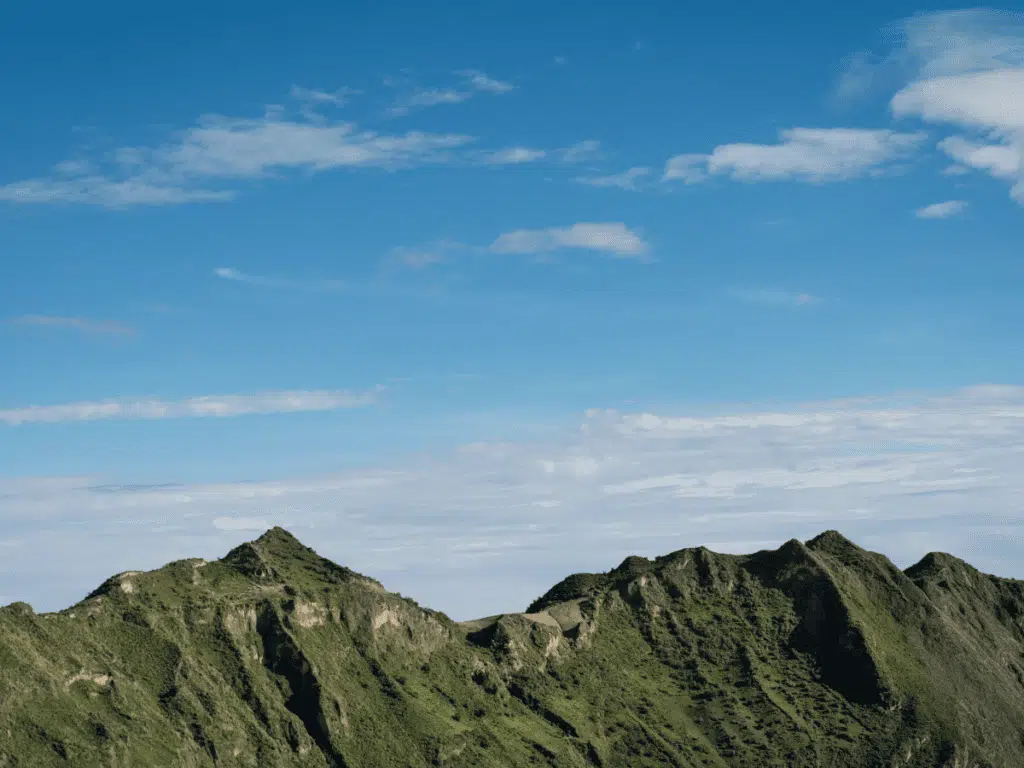
Travel Essential
Don’t head out on your adventure without comprehensive travel insurance! Good travel insurance may cover lost or stolen gear, medical emergencies, delayed or canceled flights, and more. Check out the policies available from SafetyWing or compare plans using Visitors Coverage.
Visit Quilotoa
Quilotoa is quite a small town and it’s extremely remote. It’s really more of an outpost, a cluster of a dozen or so buildings near the rim of the crater lake, mostly designed to cater to Laguna Quilotoa visitors.
You can easily walk through the entire town of Quilotoa in less than five minutes, and there is not much to see beyond a few hotels and guesthouses, a few restaurants and cafes, and shops for souvenirs.
With this in mind, come prepared for the experience. Bring what you think you’ll need for the entirety of your trip – don’t expect to find a well-stocked grocery store or pharmacy here.
In some of my earlier visits back in 2012 and 2014, there was still no internet in the entire town, just to put into some perspective how remote the place is.
ATMs in Quilotoa
Unless something has changed very recently, Quilotoa does not have an ATM, and the small towns along the rest of the Quilotoa Loop trek don’t have them either. Plus, as in most of Ecuador, many places don’t accept credit cards, so make sure you come prepared to pay for everything in cash.
Bring all the cash you’ll need while you’re here, plus a “buffer” of cash just in case you end up needing more along the way than you think you will.
Stores in Quilotoa
The stores in Quilotoa are limited to tiny markets with non-perishable foods like chips and soda, and stores aimed at visitors, selling things like handicrafts.
When departing Quilotoa or Latacuna, come prepared with any products you might need from a pharmacy or grocery store while you’re in Quilotoa, as you probably won’t be able to find those here.
Where To Stay in Quilotoa
There are just a handful of Quilotoa accommodation options, probably about five small hotels and hostels in total, and many are similar in style and price. However, there are definitely some better than others, and with better amenities than others.
These two recommendations below are definitely the best options in town, including one I came back to several times (Hosteria Alpaka Quilotoa)!
Hostería Alpaka Quilotoa ($ – $$))
Hosteria Alpaka Quilotoa – I stayed here every time I visited Quilotoa! The rooms are pretty spartan, but the beds are SO comfortable.
I’m not normally one to be too picky about beds, but I specifically remember being thrilled by how comfortable the bed was, especially after a long day of hiking. Rooms have a little wood-burning stove which will keep you very toasty at night.
Hostería Chukirawa ($ – $$)
Hosteria Chukirawa – This pleasant hostel has private rooms as well as dorm rooms and has more of a friendly hostel feel with a large open space and lounge in the center of the building.
Not only is breakfast included in the price, but DINNER is included as well, so prices are a little higher than an average hostel but worth it! Most Quilotoa accommodation options include at least one meal in the price of a room, so make sure to ask!
Best Hotels & Hostels in Quilotoa
- Hosteria Chukirawa ($ – $$)
- Hosteria Alpaka Quilotoa ($ – $$)
- Hostal Mama Hilda ($$)
Quilotoa Restaurants
Karu Ñan
Karu Ñan is a casual restaurant near the crater lake that sells Ecuadorian food with some burger and sandwich options thrown in as well. The restaurant is really warm and inviting, and everything I’ve tried here has been great.
This is the place to order canelazo if you haven’t tried it in Ecuador yet – it’s a warm, spiced fruit drink (alcohol optional) that is wonderful after hiking around in the cold near Quilotoa.
Happy Llama
Happy Llama is a tiny cafe that sells crepes, cappuccinos, and other great coffee options that far surpass some of the others you’ll find in town. They also have drinks in the evening, including Ecuadorian craft beer.

Carley Rojas Avila is a bilingual New York-based travel writer, editor, content marketer, and the founder of the digital travel publications Explorers Away and Home to Havana. Carley is an expert on all things Latin America, the Caribbean, and Cuba, having lived and worked in four different countries in the region. Her writing has appeared on the Associated Press wires and in Travel + Leisure, Yahoo, MSN, Euronews, The Weather Channel, and more. When she's not writing about her travels, find her front row at a Bad Bunny concert, befriending street cats, and taste-testing every pizza in Havana.

